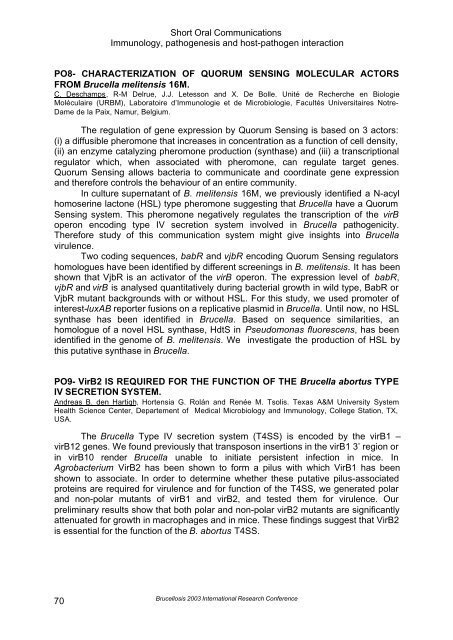Brucellosis 2003 proceedings - PHIDIAS
Brucellosis 2003 proceedings - PHIDIAS
Brucellosis 2003 proceedings - PHIDIAS
Create successful ePaper yourself
Turn your PDF publications into a flip-book with our unique Google optimized e-Paper software.
Short Oral Communications<br />
Immunology, pathogenesis and host-pathogen interaction<br />
PO8- CHARACTERIZATION OF QUORUM SENSING MOLECULAR ACTORS<br />
FROM Brucella melitensis 16M.<br />
C. Deschamps, R-M Delrue, J.J. Letesson and X. De Bolle. Unité de Recherche en Biologie<br />
Moléculaire (URBM), Laboratoire d’Immunologie et de Microbiologie, Facultés Universitaires Notre-<br />
Dame de la Paix, Namur, Belgium.<br />
The regulation of gene expression by Quorum Sensing is based on 3 actors:<br />
(i) a diffusible pheromone that increases in concentration as a function of cell density,<br />
(ii) an enzyme catalyzing pheromone production (synthase) and (iii) a transcriptional<br />
regulator which, when associated with pheromone, can regulate target genes.<br />
Quorum Sensing allows bacteria to communicate and coordinate gene expression<br />
and therefore controls the behaviour of an entire community.<br />
In culture supernatant of B. melitensis 16M, we previously identified a N-acyl<br />
homoserine lactone (HSL) type pheromone suggesting that Brucella have a Quorum<br />
Sensing system. This pheromone negatively regulates the transcription of the virB<br />
operon encoding type IV secretion system involved in Brucella pathogenicity.<br />
Therefore study of this communication system might give insights into Brucella<br />
virulence.<br />
Two coding sequences, babR and vjbR encoding Quorum Sensing regulators<br />
homologues have been identified by different screenings in B. melitensis. It has been<br />
shown that VjbR is an activator of the virB operon. The expression level of babR,<br />
vjbR and virB is analysed quantitatively during bacterial growth in wild type, BabR or<br />
VjbR mutant backgrounds with or without HSL. For this study, we used promoter of<br />
interest-luxAB reporter fusions on a replicative plasmid in Brucella. Until now, no HSL<br />
synthase has been identified in Brucella. Based on sequence similarities, an<br />
homologue of a novel HSL synthase, HdtS in Pseudomonas fluorescens, has been<br />
identified in the genome of B. melitensis. We investigate the production of HSL by<br />
this putative synthase in Brucella.<br />
PO9- VirB2 IS REQUIRED FOR THE FUNCTION OF THE Brucella abortus TYPE<br />
IV SECRETION SYSTEM.<br />
Andreas B. den Hartigh, Hortensia G. Rolán and Renée M. Tsolis. Texas A&M University System<br />
Health Science Center, Departement of Medical Microbiology and Immunology, College Station, TX,<br />
USA.<br />
The Brucella Type IV secretion system (T4SS) is encoded by the virB1 –<br />
virB12 genes. We found previously that transposon insertions in the virB1 3’ region or<br />
in virB10 render Brucella unable to initiate persistent infection in mice. In<br />
Agrobacterium VirB2 has been shown to form a pilus with which VirB1 has been<br />
shown to associate. In order to determine whether these putative pilus-associated<br />
proteins are required for virulence and for function of the T4SS, we generated polar<br />
and non-polar mutants of virB1 and virB2, and tested them for virulence. Our<br />
preliminary results show that both polar and non-polar virB2 mutants are significantly<br />
attenuated for growth in macrophages and in mice. These findings suggest that VirB2<br />
is essential for the function of the B. abortus T4SS.<br />
70<br />
<strong>Brucellosis</strong> <strong>2003</strong> International Research Conference
















